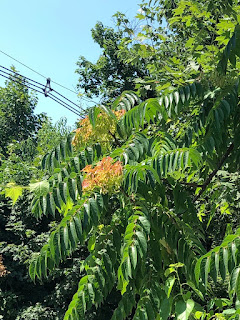Plant List Eastside Starting at Main Entrance
This is intended to be a skeleton list with minimal information at the start, to be edited as desired in the future. it is partly just curiosity but might be useful for teachers, counselors, or passer-bye with an interest. Each plant is like a Russian doll with questions inside of questions. Is the ID correct, or if generally correct can it be more precise.? What do the leaves tell you as far as health and common diseases? Is the tree part of the landscaper's design or an invader? Is the plant native? How does it change with the seasons and with the years? Unending room for investigation.
I am a fan of the latin names, for precision, but will let someone else fill that in later. I will use odd numbers to allow for editing but there may be need for subcategories. There will be only minimal comments at first.
Southeast corner:
1. Ash tree--small spindly tree closest to road. twice the size last fall. Which Ash? Our first example of opposite leaves and the MAD Horse acronym. First compound leaf.
3. Maple Tree-- large, old, there before the landscaping. We are not jumping into species but this tree bleeds white, has white sap and may be a Norway maple.
5. English Ivy around the base of the tree. Do we love it and leave it? Can it be forage in hard times?
7. Yew tree or large bush at the base of the Maple. Can be medicinal and can be poisonous.
9. Oak tree. Still south end but closer to driveway. Sharp points tend toward red oak. Clearly planted. Common comments are about the acorn production, good and slow years. But that may be in the future for this smaller tree.
11. Small planted Maple. The leaves are obviously different from the Norway. How does this fit with MAD Horse and the opposite leaves?
13. Serviceberry. multi stemmed, smaller more of a bush. The photo shows the fruit in June with the interesting infection. Common and complex. Often discuss the origin of the name "Service". There are a couple more scattered in the area, same disease.
15. Redbuds. Three of these, landscaped, between the road and the evergreens to the east. Common discussion is cauliflory, growing buds directly from limbs and trunk. Fruit is interesting.
17. Ash. Another ash but bearing seeds here in June. What type? Landscaped as same size as the landscaped maple and oak. Comments are diseases, emerald ash borer, check how the seed falls from your hand.
19. Cryptomeria. evergreen close to the fence. Comments are Japanese non-native. Possibly very allergenic in the spring.
21. Eastern red cedar. The evergreen near the fence, furthest south and closest to the large old maple. Comments are that it is common, a first responder ( fills in openings), and that it is a juniper not a cedar.
Not sure is this was landscaped.
23. Arborvitae. 3 of these near the fence. comments are often about vitamin tea brewed from the leaves which saved early explorers from scurvy.
25. Tulip poplar. Back near the road. Landscaped tree. Comments on the more dramatic flower.
27, Elm. Last of the planted hardwoods in this group. note the uneven leave base. Comments are on the diseases, so since this was planted should be a resistant species.
Around fifteen plants may be enough for one area, to allow ease of editing and comments. I am curious about the tall tree next-door that overshadows this plot. It may be a fir needs more investigation.



Comments
Post a Comment